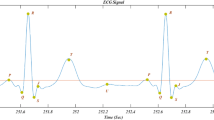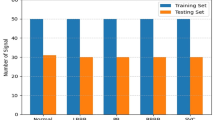Abstract
Abnormal change in ST morphology is an important indicator for heart disease, especially for myocardial ischemia. The automatic classification of ST morphology can provide valuable information for helping physicians in the diagnosis of myocardial ischemia, especially in long-term and remote electrocardiogram (ECG) monitoring environments. In order to provide more accurate and efficient ST morphology classification for long-term and remote ECG monitoring applications, a simple rule-based ST morphology classification method is proposed that identifies ST segments with the normal morphology type and five abnormal morphology sub-types: concave or convex elevation, up-sloping, down-sloping, or horizontal depression. The proposed method consists of the following steps: (1) 0.05–45 Hz band-pass filtering; (2) signal quality assessment; (3) R peak detection; (4) removal of ECG beats with anomalous RR interval; (5) identification of start and end points of ST segment; (6) determination of sliding baseline; and (7) rule-based morphological classification of each ST segment. A total of 17,314 ECG beats were selected from the European ST–T ECG database, with 11,461 beats used for training and 5853 beats used for testing. Four quantitative parameters, namely sensitivity, positive predictive rate, F-measure, and G-mean, were used as classification indices. The final classification accuracy for the training and testing data are 91.8 and 90.1 % respectively, indicating the clinical significance of the proposed method. This method is clinically and pathophysiologically important, and is an important contribution to the early detection of the potential risk of myocardial ischemia in heart disease patients in long-term and remote ECG monitoring.






Similar content being viewed by others
References
Wang, L. P., & Dong, J. (2010). The advance research and analysis of electrocardiogram pattern classification. Chinese Journal of Biomedical Engineering, 29, 916–925.
Zhang, Y. T., Liu, C. Y., Wei, S. S., Wei, C. Z., & Liu, F. F. (2014). ECG quality assessment based on a kernel support machine and genetic algorithm with a feature matrix. Journal of Zhejiang University Science, 15, 564–573.
de Chazal, P., O’Dwyer, M., & Reilly, R. B. (2004). Automatic classification of heartbeats using ECG morphology and heartbeat interval features. IEEE Transactions on Biomedical Engineering, 51, 1196–1206.
Exarchos, T. P., Papaloukas, C., Fotiadis, D. I., & Michalis, L. K. (2006). An association rule mining-based methodology for automated detection of ischemic ECG beats. IEEE Transactions on Biomedical Engineering, 53, 1531–1540.
Dranca, L., Goni, A., & Illarramendi, A. (2009). Real-time detection of transient cardiac ischemic episodes from ECG signals. Physiological Measurement, 30, 983–998.
Song, J. Z., Yan, H., Li, L., & Yang, X. L. (2011). A squeeze approach for electrocardiogram ST segment detection based on R wave and T wave. Journal of Biomedical Engineering, 28, 855–859.
Soria-Olivas, E., Martinez-Sober, M., Calpe-Maravilla, J., Guerrero-Martinez, J. F., Chorro-Gaso, J., & Espi-Lopez, J. (1998). Application of adaptive signal processing for determining the limits of P and T waves in an ECG. IEEE Transactions on Biomedical Engineering, 45, 1077–1080.
Yu, S. C., Gao, L., Xue, Y., Huang, J. L., & Cui, X. W. (2008). ECG T wave detector based on genetic algorithms and back propagation neural network. Chinese Journal of Mechanical Engineering, 27, 481–484.
Zhang, Q. H., Manriquez, A. I., Medigue, C., Papelier, Y., & Sorine, M. (2006). An algorithm for robust and efficient location of T wave ends in electrocardiograms. IEEE Transactions on Biomedical Engineering, 53, 2544–2552.
Smrdel, A., & Jager, F. (2004). Automated detection of transient ST-segment episodes in 24 h electrocardiograms. Medical & Biological Engineering & Computing, 42, 303–311.
Andreao, R. V., Dorizzi, B., Boud, J., & Mota, J. C. M. (2004). ST-segment analysis using hidden Markov Model beat segmentation application to ischemia detection. Computers in Cardiology, 31, 381–384.
Langley, P., Bowers, E. J., Wild, J., Drinnan, M. J., Allen, J., Brown, N., & Murray, A. (2003). An algorithm to distinguish ischaemic and non-ischaemic ST changes in the holter ECG. Computers in Cardiology, 30, 239–242.
Jeong, G. Y., Yu, K. H., Yoon, M. J., & Inooka, E. (2010). ST shape classification in ECG by constructing reference ST set. Medical Engineering & Physics, 32, 1025–1031.
Song, J. Z., Yan, H., Yao, Y. H., & Zhang, L. (2011). Research progress in detecting methods for myocardial ischemia based on electrocardiography ST–T complex. Space Medicine & Medical Engineering, 24, 146–150.
Yu, X. M., & Zhang, Y. (2009). Detection method of ST segment change in real-time electrocardiography monitoring. Computational Engineering, 35, 252–253.
Wang, Z. X., Zhang, S. J., & Zhang, X. P. (2011). Shape recognition algorithm for ST-segment of ECG signal. Journal of Computer Applications, 31, 2811–2813.
Mao, L., Zhang, G. M., & Sun, J. X. (2009). Research on shape analysis of ST segments in ECG signal. Signal Processing, 25, 1360–1365.
Jernberg, T., Lindahl, B., & Wallentin, L. (1999). ST-segment monitoring with continuous 12-lead ECG improves early risk stratification in patients with chest pain and ECG nondiagnostic of acute myocardial infarction. Journal of the American College of Cardiology, 34, 1413–1419.
Taddei, A., Distante, G., Emdin, M., Pisani, P., Moody, G. B., Zeelenberg, C., & Marchesi, C. (1992). The European ST–T Database standard for evaluating systems for the analysis of ST–T changes in ambulatory electrocardiography. European Heart Journal, 13, 1164–1172.
Hammill, S. C., & Freed, M. S. (2008). Approach to ECG interpretation. In J. H. O’Keefe (Ed.), The complete guides to ECGs (Vol. 10). Boston: Physicians’ Press.
Liu, C. Y., Li, P., Maria, C. D., Zhao, L. N., Zhang, H. G., & Chen, Z. Q. (2014). A multi-step method with signal quality assessment and fine-tuning procedure to locate maternal and fetal QRS complexes from abdominal ECG recordings. Physiological Measurement, 35, 1665–1683.
Liu, C. Y., Li, P., Zhao, L. N., Liu, F. F., & Wang, R. X. (2011). Real-time signal quality assessment for ECGs collected using mobile phones. Computing in Cardiology Hangzhou China, 38, 357–360.
Liu, C. Y., Li, P., Zhang, Y. T., Zhang, Y., Liu, C. C., & Wei, S. S. (2013). A construction method of personalized ECG template and its application in premature ventricular contraction recognition for ECG mobile phones. World Congress on Medical Physics & Biomedical Engineering, 39, 585–588.
Okada, Y., Yoto, T. Y., Suzuki, T., Sakuragawa, S., Sakakibara, H., Shimoi, K., & Sugiura, T. (2012). Wearable ECG recorder with acceleration sensors for monitoring daily stress. Journal of Medical and Biological Engineering, 33, 420–426.
Singh, Y. N., & Gupta, P. (2009). An efficient and robust technique of T wave delineation in electrocardiogram. In Biosignals-proceedings of international conference bio-inspired system signal processing (Vol. 52, pp. 146–154)
Yang, L., Zhang, S., Li, X. Y., & Yang, Y. M. (2010). Removal of pulse waveform baseline drift using cubic spline interpolation. In International conference on bioinformatics and biomedical engineering (Vol. 1, pp. 1–3)
Chen, H. C., & Chen, S. W. (2003). A moving average based filtering system with its application to real-time QRS detection. Computers in Cardiology, 30, 585–588.
Daskalaki, S., Kopanas, I., & Avouris, N. (2006). Evaluation of classifiers for an uneven class distribution problem. Applied Artificial Intelligence, 20, 381–417.
Dalu, S., & Pawar, N. (2012). Detection and classification of QRS and ST segment using WNN. International Journal of Computer Science and Network, 1, 30–36.
Shi, L., Yang, C. Y., Zhang, J. Y., & Li, H. (2007). Recognition of ST segment of electrocardiogram based on wavelet transform. Life Science Journal, 4, 90–93.
Acknowledgments
This research was sponsored by the National Natural Science Foundation of China (Grants 51075243 and 61201049), the Natural Science Foundation of Shandong Province in China (Grant 2014ZRE2733), and the Excellent Young Scientist Awarded Foundation of Shandong Province in China (Grant BS2013DX029).
Author information
Authors and Affiliations
Corresponding authors
Additional information
Mingfang Xu and Shoushui Wei contributed equally to this work.
Rights and permissions
About this article
Cite this article
Xu, M., Wei, S., Qin, X. et al. Rule-Based Method for Morphological Classification of ST Segment in ECG Signals. J. Med. Biol. Eng. 35, 816–823 (2015). https://doi.org/10.1007/s40846-015-0092-x
Received:
Accepted:
Published:
Issue Date:
DOI: https://doi.org/10.1007/s40846-015-0092-x




